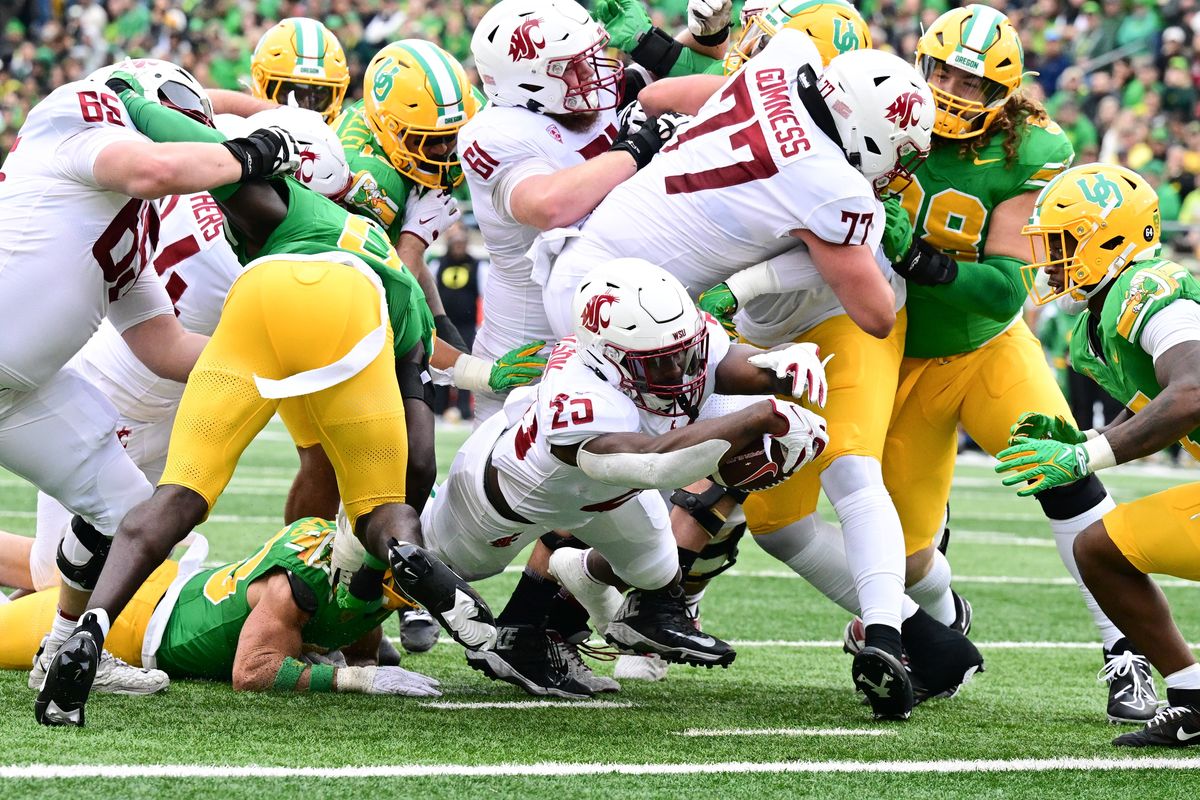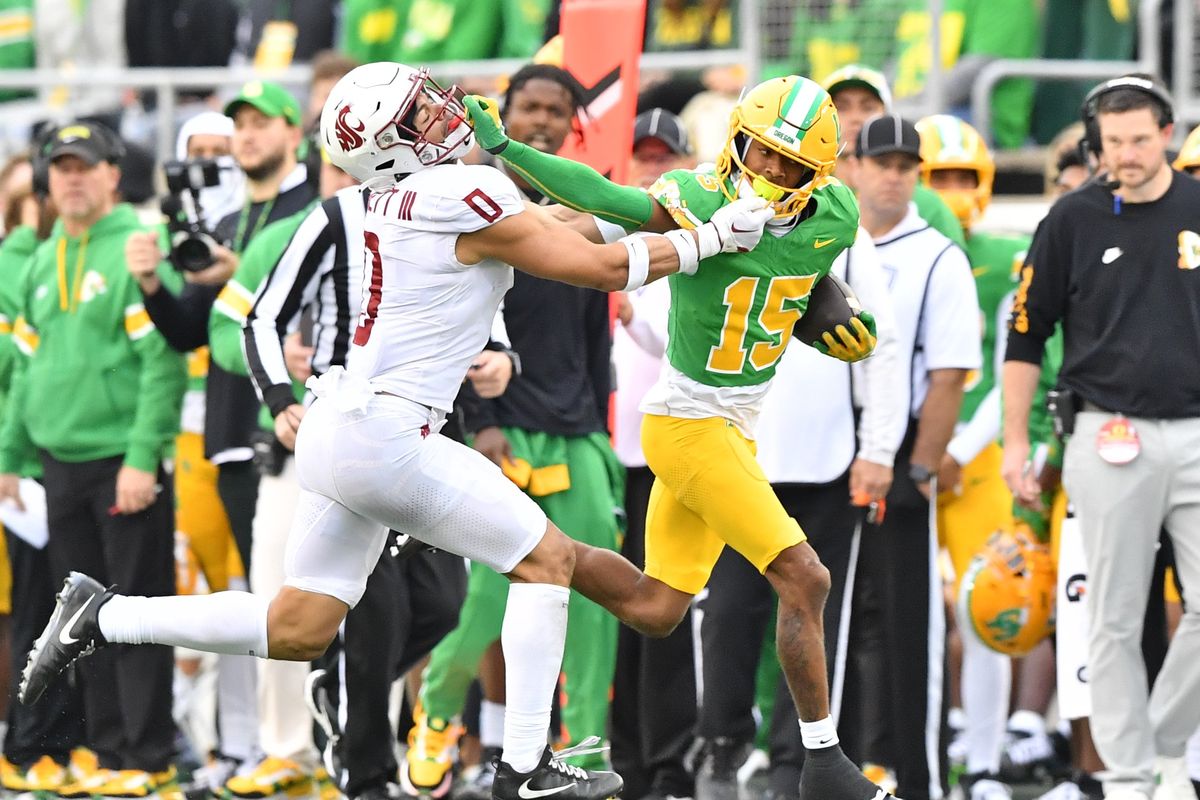Analysis: WSU got worn down by Oregon, but the Cougs improved in ways that matter

EUGENE – The bloody knee stood out the most. As Cameron Ward stood in a circle with the other Washington State quarterbacks, offensive coordinator Ben Arbuckle raising his voice over the sound of Oregon-green equipment trucks to discuss their group’s loss to the No. 9 Ducks on Saturday, Ward looked down.
He was listening, just disappointed. Discouraged by the way his offense looked sharp for the first 30 minutes and dull for the next 30. Frustrated that he couldn’t help his Cougars avoid a third straight loss. As the sun set on Autzen Stadium and teammates shuffled around to pack up their things, Ward stood still amid a blur of bustling.
On his white pants, right below the knee, was a bright red spot about the size of a coaster, caused by a scrape. He had suffered it an hour earlier, diving forward for a first down, moving his Cougars farther into Ducks territory. They failed to score on that drive. In the second half , Washington State’s offense looked lifeless, worn down by Oregon’s abundance of athletes.
“I think in the second half it started to get a little bit leaky,” WSU head coach Jake Dickert said of his team’s pass-protection in this 38-24 setback. “(Ward) had to do more of those scramble plays. We were off target and timing a little bit.”
During the next four weeks of their season, however, the Cougars won’t face athletes like Oregon’s. They won’t face running backs like Bucky Irving, who rumbled for 129 yards and two scores, and they won’t face quarterbacks like Bo Nix, the Heisman Trophy candidate who racked up nearly 300 yards through the air.
Instead, WSU’s next four games are at Arizona State, vs. Stanford, at California and vs. Colorado. They all should be winnable.
Those are far more winnable than a road game at Oregon, a top-10 team for a reason. Those teams don’t have athletes like the ones in Eugene, where Washington State surprised some 50,000 people in the stadium by keeping it a one-score game at halftime, the most encouraging part for WSU.
If Ward can complete 34 of 48 passes for 438 yards and a touchdown against Oregon, can’t he do that against the Cougars’ next four Pac-12 opponents? If receiver Lincoln Victor can record a school-record 16 catches for 161 yards against the Ducks – partially a function of Oregon eschewing the drop-eight scheme that WSU’s previous two opponents employed – can’t he dice up the secondaries of the next four rivals?
“He’s just a tough player,” Ward said of Victor. “He was someone that we missed for a couple games, but he brings a different type of energy to this offense. It’s good to have him back healthy.”
More important, WSU’s offensive line proved it can achieve similar outings. Left tackle Esa Pole, left guard Christian Hilborn, center Konner Gomness, right guard Brock Dieu, right tackle Fa’alili Fa’amoe may have given up six sacks, but they kept Ward clean for two quarters. The effort should give them confidence moving forward and won’t be as necessary against the next few teams in the way .
“If we can stay healthy, we really like this lineup. We’ll probably use it as we go,” Dickert said. “I think that’s the consistency that we need.”
The outcome should prove that Washington State can build on this game, and not just in the coach-speak way. The most important development has to do with the Cougars’ offensive line – and one guy running behind them.
In their past two games, the linemen showed a concerning inability to pass block – the entire reason they were brought to pass-heavy WSU. Even against three- and four-man rushes, they couldn’t hold up, which thwarted the entire operation. Ward had to scramble even when he wasn’t blitzed, which made his offense look stale and predictable, especially in last week’s loss to Arizona.
On Saturday, they looked sturdy. Dieu picked up blitzes. Pole looked athletic on the edge. Gomness held his own, as did Fa’amoe, who was coming off a forgettable showing.
They even proved they can move the ball in short-yardage situations, maybe the most promising development of all for WSU. On first-and-goal from the 4, they moved bodies to make way for running back Nakia Watson, who sneaked in. On a second-and-2 in the third quarter, they paved a path for Watson, who got that and more.
Consider a fourth-down play late in the third quarter. The Cougars’ offensive line blocked well. It created just enough of a hole. The Cougars converted. The running back on the play was … a walk-on.

Dylan Paine is making his case for a scholarship, and not just because of his outing on Saturday, but because of how he figures to remain a staple in this offense in the weeks to come. He has blazing speed, maybe the most in WSU’s running back room, and he’s physical enough to stay on his feet and pick up blitzes.
If the Cougars want to activate their running game – which will be necessary in the next five games – they might consider sticking with Paine. He’s a downhill runner, a quick back, a guy who picks up speed and puts his head down until a defender – usually more than one – brings him down. He saw meaningful playing time on Saturday. That was no accident.
“Dylan’s earned everything he’s ever gotten in our program, period,” Dickert said. “And we don’t put anybody out there that we don’t feel earned it and can give us an edge. In the run game, we need to get downhill and be physical. He’s showing the willingness to want to do things right in pass-protection, and he’s earned that.”
WSU got whipped in the second half, though, and if you’re a Cougars fan, there are reasons to be concerned beyond just playing Oregon.
For the second straight week, tackling issues plagued WSU, illustrating a willingness to hit hard but not wrap up. Safety Jaden Hicks was guilty on one occasion. Linebacker Kyle Thornton, by his own admission after the game, was also. It’s enough of an issue that Dickert addressed it last week.
For the second straight game, safety Sam Lockett III missed a tackle on a running back up the middle, resulting in a touchdown. Late in the third quarter, his man was Irving, who came sprinting up the gut. He juked Lockett, giving him a bunch of green grass, good for a touchdown that put the game all but out of reach.
The weirdest play came early in the third quarter, when Nix completed a pass in the flat to Irving, who burst upfield. WSU linebacker Devin Richardson was in position to make a play, but he appeared to have no idea where the ball was, his back turned to Irving as he came surging upfield. With his eyes nowhere near the play, Richardson was blown up on a block, and Irving waltzed into the end zone.
The most consequential play, though, came courtesy of tight end Cooper Mathers. Late in the second quarter, with WSU driving, Ward hit Victor for back-to-back big gains. The Cougars looked poised to take the lead. Then, on a trick play, Ward found a wide-open Mathers, who dropped an easy pass along the sideline.
Three plays later, WSU turned it over on downs.
Those are plays that swing games, the type where the opponent doesn’t matter as much as the execution. The Cougars can’t keep missing tackles. They can’t keep dropping passes. More important, they have to know where the ball is.
But those are also problems they can fix, and against the opponents coming up, they should have an easier time doing so. For the Cougars, it may be time to take the good stuff and wipe the rest.